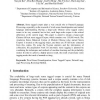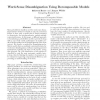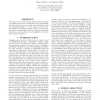80 search results - page 5 / 16 » Simple Features for Chinese Word Sense Disambiguation |
FSKD
2009
Springer
13 years 4 months ago
2009
Springer
Sense Induction is the process of identifying the word sense given its context, often treated as a clustering task. This paper explores the use of spectral cluster method which in...
LKR
2008
13 years 8 months ago
2008
Sense tagged corpus plays a very crucial role to Natural Language Processing, especially on the research of word sense disambiguation and natural language understanding. Having a l...
AAAI
2006
13 years 8 months ago
2006
We present an extensible supervised Target-Word Sense Disambiguation system that leverages upon GATE (General Architecture for Text Engineering), NSP (Ngram Statistics Package) an...
ACL
1994
13 years 8 months ago
1994
Most probabilistic classi ers used for word-sense disambiguationhave either been based on onlyone contextual feature or have used a model that is simply assumed to characterize th...
NAACL
1994
13 years 8 months ago
1994
This paper presents and evaluates models created according to a schema that provides a description of the joint distribution of the values of sense tags and contextual features th...



